Report of Findings
Accurate Diagnosis & Management of Scoliosis
“Scoliosis surgery occurs with the failure of non-surgical management.”
Scoliosis can affect people of all age ranges:
- Infantile: 0 – 3 Years
- Juvenile: 4 years to puberty onset (4 – 10 years)
- Adolescent: Puberty onset to epiphyseal closure (10 – 18 years)
- Adult: Pre-existing AIS in an Adult OR new onset of Degenerative De Novo Scoliosis (DDS)
- Late Stage Adult: 50 years plus
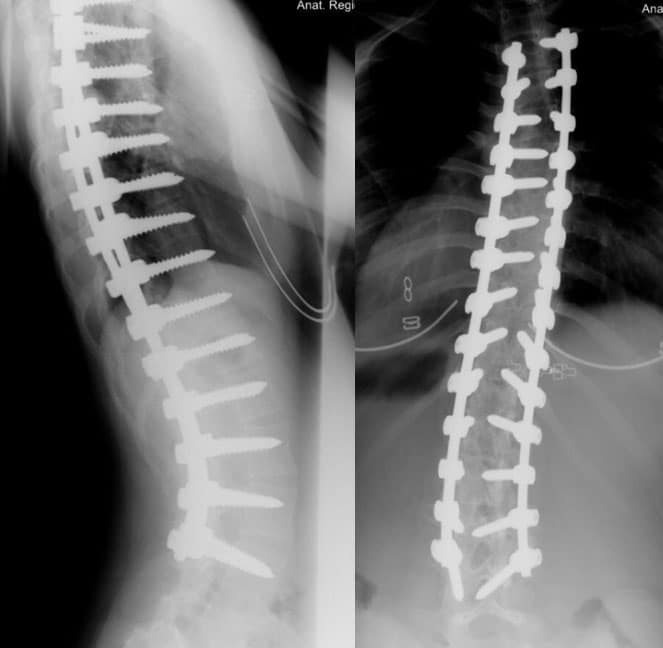
Select The Age Group of The Patient:
Types of Scoliosis and Causes
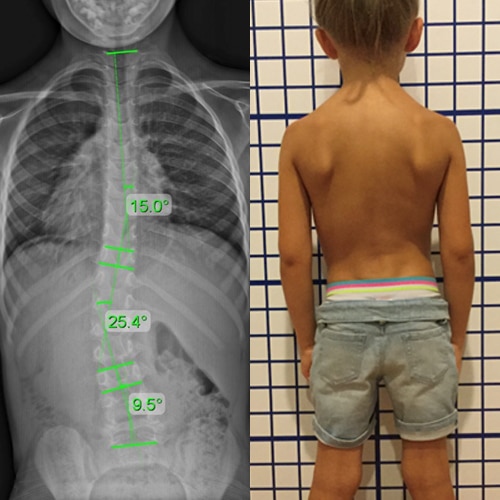
Idiopathic
- Unknown cause
- Consensus is it is multi-factorial
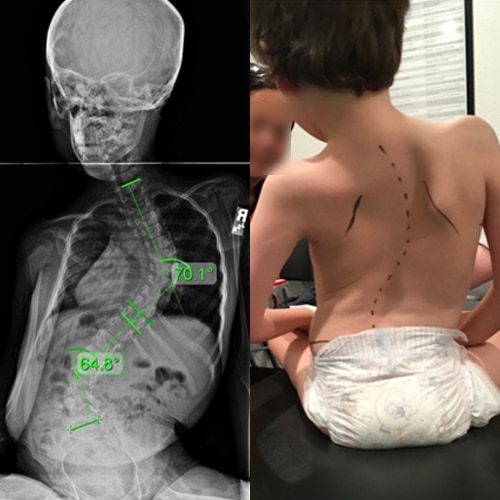
Neuromuscular
- Neuromuscular syndromes like: Cerebral Palsy, Marfan’s Syndrome, Neurofibromatosis, etc.
- Normally a connective tissue disorder causing either laxity or contractive problem of the soft tissue
- Can be neurological issue, like tethered spinal cord, syrinx, etc.
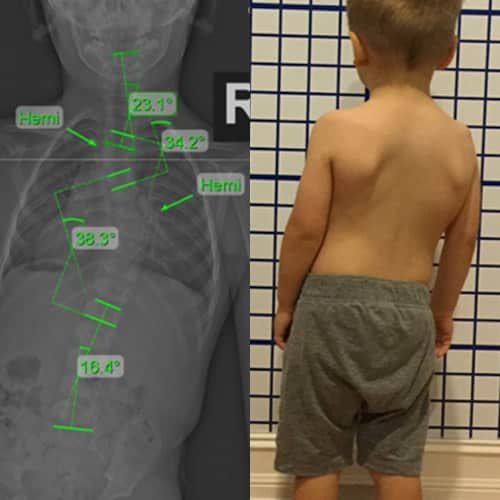
Congenital
- Hemivertebra (a misshapen vertebra since birth)
What Type of Scoliosis is Your Case?
Types of Scoliosis and Causes
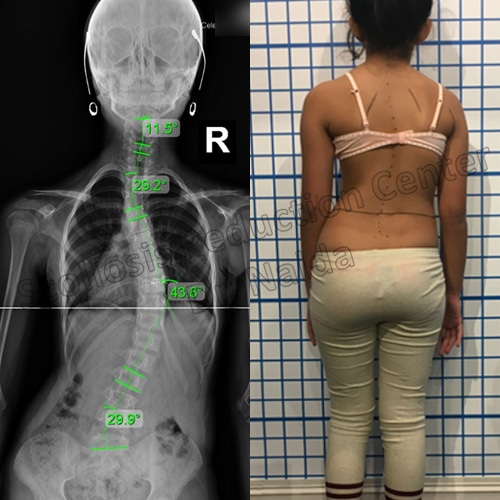
Idiopathic
- Unknown cause
- Consensus is it is multi-factorial
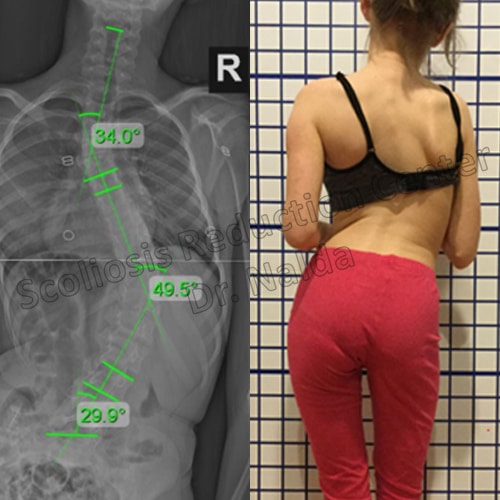
Neuromuscular
- Neuromuscular syndromes like: Cerebral Palsy, Marfan’s Syndrome, Neurofibromatosis, etc.
- Normally a connective tissue disorder causing either laxity or contractive problem of the soft tissue
- Can be neurological issue, like tethered spinal cord, syrinx, etc.
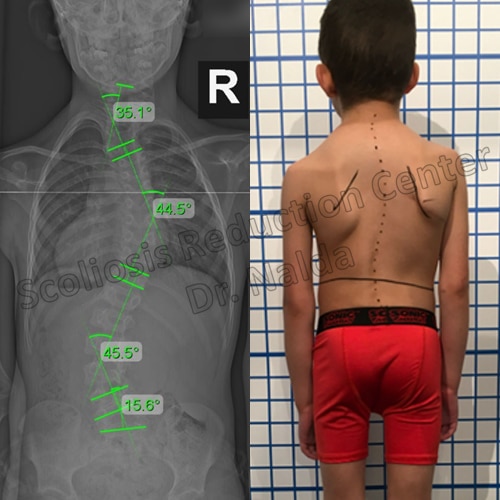
Congenital
- Hemivertebra (a misshapen vertebra since birth)
What Type of Scoliosis is Your Case?
Types of Scoliosis and Causes
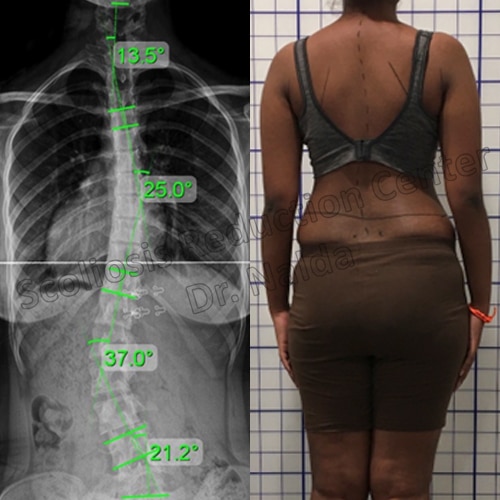
Idiopathic
- Unknown cause
- Consensus is it is multi-factorial
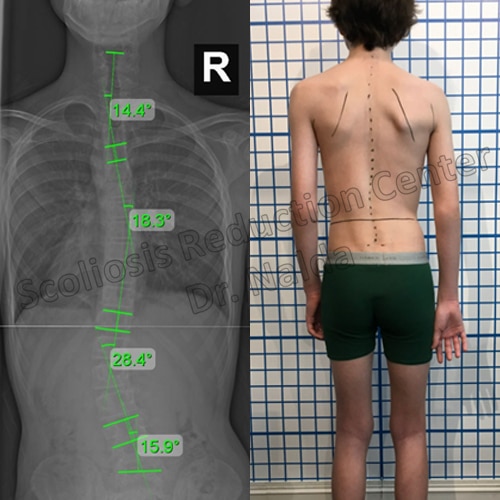
Neuromuscular
- Neuromuscular syndromes like: Cerebral Palsy, Marfan’s Syndrome, Neurofibromatosis, etc.
- Normally a connective tissue disorder causing either laxity or contractive problem of the soft tissue
- Can be neurological issue, like tethered spinal cord, syrinx, etc.
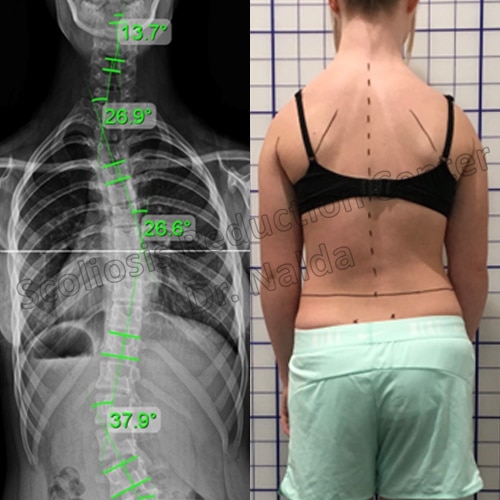
Congenital
- Hemivertebra (a misshapen vertebra since birth)
What Type of Scoliosis is Your Case?
Types of Adult Scoliosis and Causes
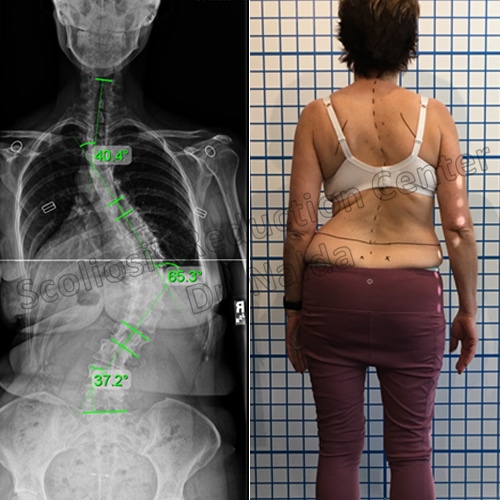
Adolescent Scoliosis in the Adult
- Diagnosis as a child and now the patient is an adult
- Many cases go undiagnosed because they never progress to a large enough curve as an adolescent, however they do continue to progress as adults until they cause problems
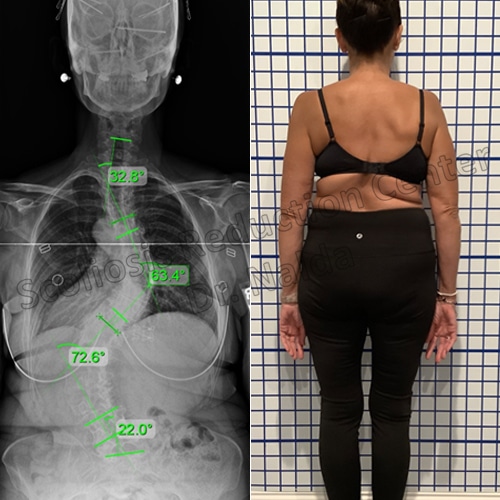
Adult Degenerative De-Novo Scoliosis (DDS)
- Most commonly De-Novo Scoliosis starts in women around the time of menopause. In men it usually occurs after the age of 70.
- Pain and disability are the most common symptoms
- Rapid degenerative change including development of segmental lateral instability (lateral listhesis) and loss of the lumbar lordosis or development of a lumbar kyphosis.
- Almost exclusively develops in the lumbar and thoracolumbar spine. Scoliosis can develop in adults with no hx of adolescent scoliosis
- DDS is a disease that worsens over time without intervention
What Type of Scoliosis is Your Case?
Types of Late Stage Adult Scoliosis and Causes
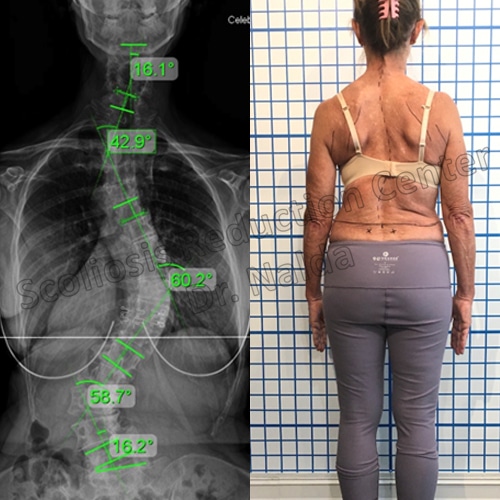
Adolescent Scoliosis in the Adult
- Diagnosis as a child and now the patient is an adult
- Many cases go undiagnosed because they never progress to a large enough curve as an adolescent, however they do continue to progress as adults until they cause problems
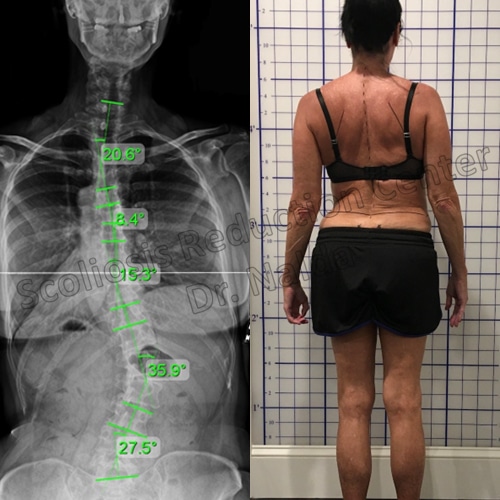
Adult Degenerative De-Novo Scoliosis (DDS)
- Most commonly De-Novo Scoliosis starts in women around the time of menopause. In men it usually occurs after the age of 70.
- Pain and disability are the most common symptoms
- Rapid degenerative change including development of segmental lateral instability (lateral listhesis) and loss of the lumbar lordosis or development of a lumbar kyphosis.
- Almost exclusively develops in the lumbar and thoracolumbar spine. Scoliosis can develop in adults with no hx of adolescent scoliosis
- DDS is a disease that worsens over time without intervention
What Type of Scoliosis is Your Case?
Scoliosis Progression in Adolescents
No matter what the cause is, progression is due to growth.
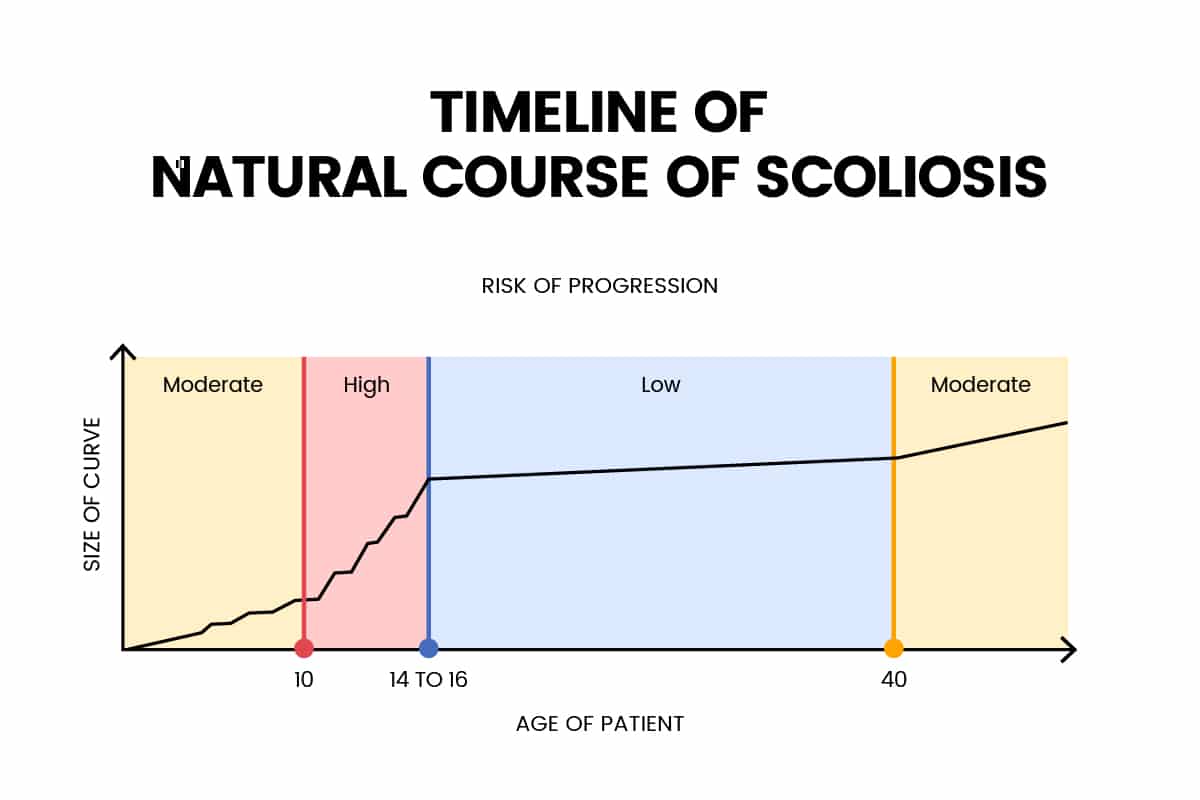
The graph illustrates the natural progression of scoliosis over a patient’s lifetime, showing that the risk of curve progression is moderate during early childhood, peaks to a high level between ages 10 and 16, and decreases to a low risk from ages 16 to 40, before increasing again to a moderate risk after age 40. This highlights the critical periods of potential curve progression, particularly during adolescence and later adulthood.
The unknown variable is how much progression will occur:
- some only a few degrees,
- some 10-20 degrees,
- some 40-50 degrees,
- some 60-80 degrees,
The largest curve I have ever seen has been 155 degrees!
Are you experiencing pain?
Scoliosis and Pain
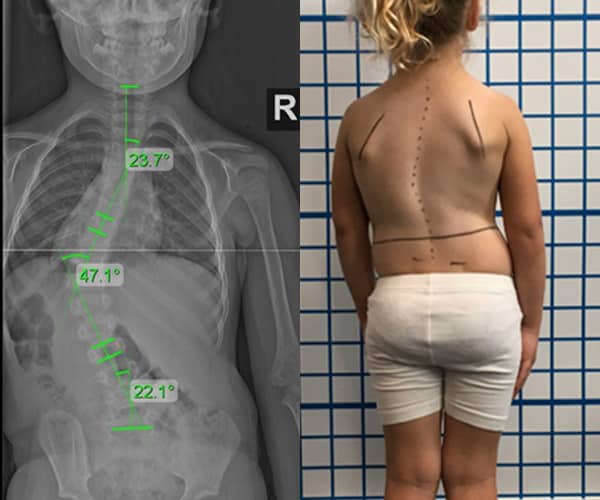
It is NOT common for children with scoliosis pain, no matter what size the curve is.
- If anything, a dull mild ache.
- This is because progression is due to growth, which is elongating.
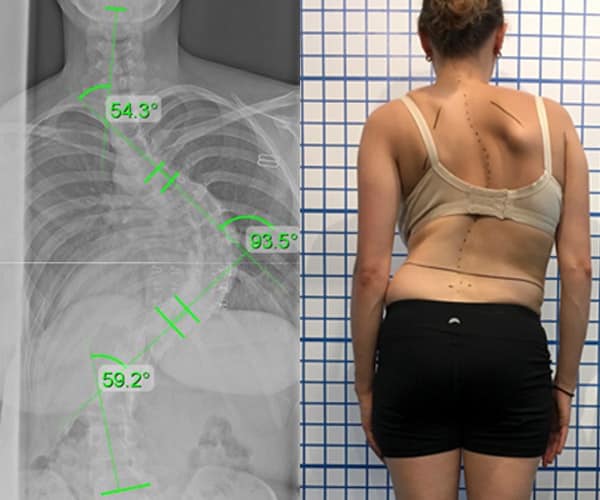
The opposite is true for adults with scoliosis, who will almost always feel pain, even with relative mild progression.
- This is because progression is due to gravity, which is almost always painful.
Types of Scoliosis and Causes
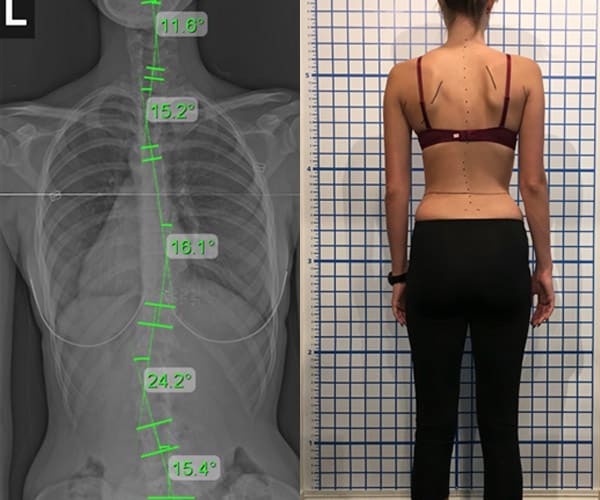
Idiopathic
- Unknown cause
- Consensus is it is multi-factorial
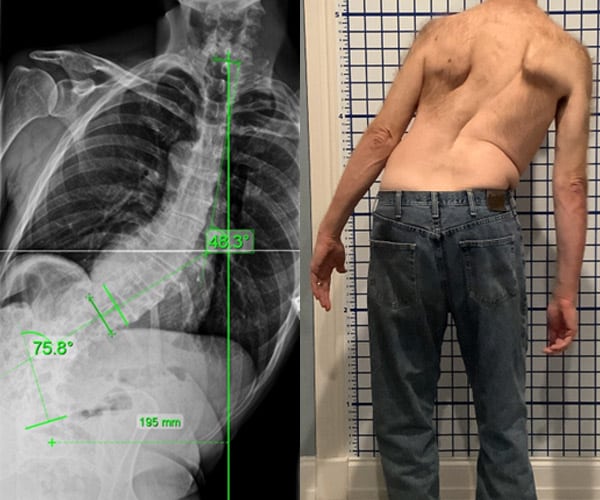
Neuromuscular
- Neuromuscular syndromes like: Cerebral Palsy, Marfan’s Syndrome, Neurofibromatosis, etc.
- Normally a connective tissue disorder causing either laxity or contractive problem of the soft tissue
- Can be neurological issue, like tethered spinal cord, syrinx, etc.
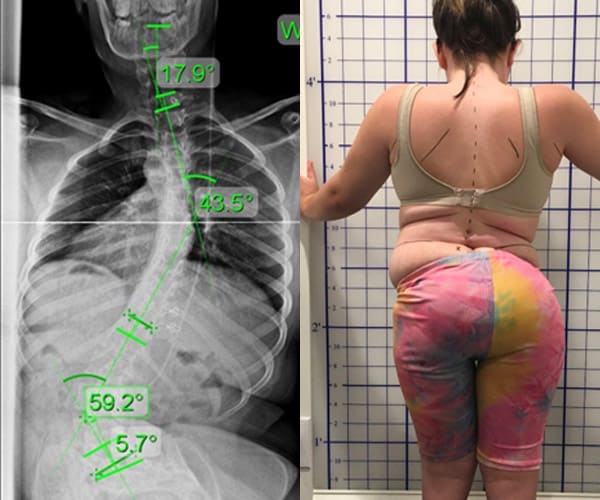
Congenital
- Hemivertebra (a misshapen vertebra since birth)
What Type of Scoliosis is Your Case?
Scoliosis Progression in Adults
Progression happens because of gravity over time.
- Compression leads to slow progression, purely depending on the size of the curve.
- As the curve becomes bigger, the rate of progression increases.
- As the patient becomes older, the rate of progression increases.
Adolescent Scoliosis in the Adult
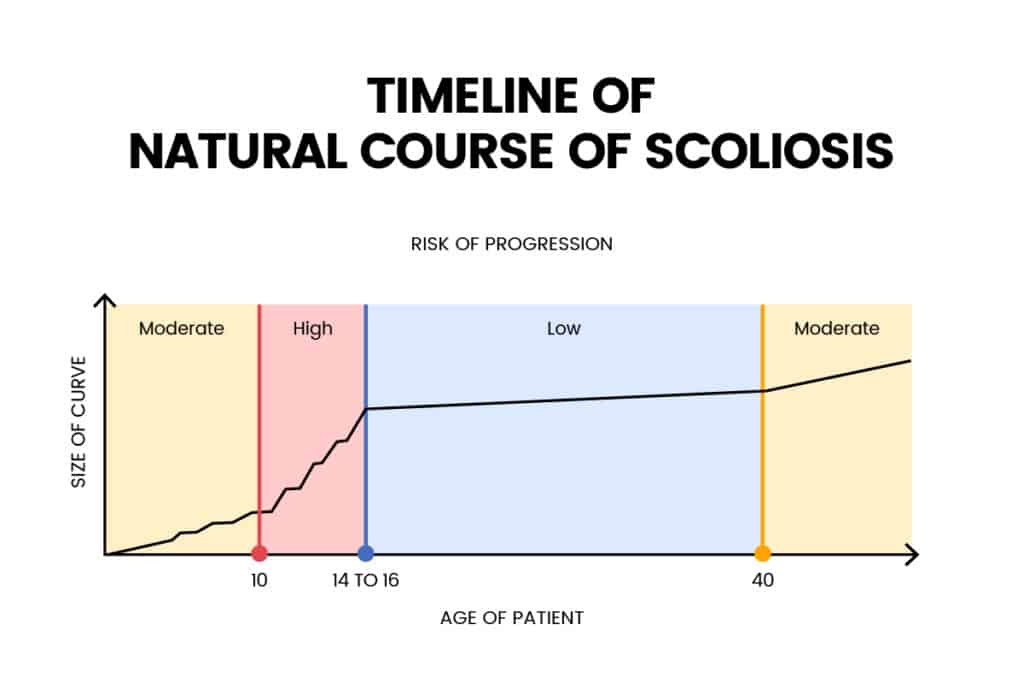
The graph illustrates the natural progression of scoliosis over a patient’s lifetime, showing that the risk of curve progression is moderate during early childhood, peaks to a high level between ages 10 and 16, and decreases to a low risk from ages 16 to 40, before increasing again to a moderate risk after age 40. This highlights the critical periods of potential curve progression, particularly during adolescence and later adulthood.
Adult Onset Scoliosis
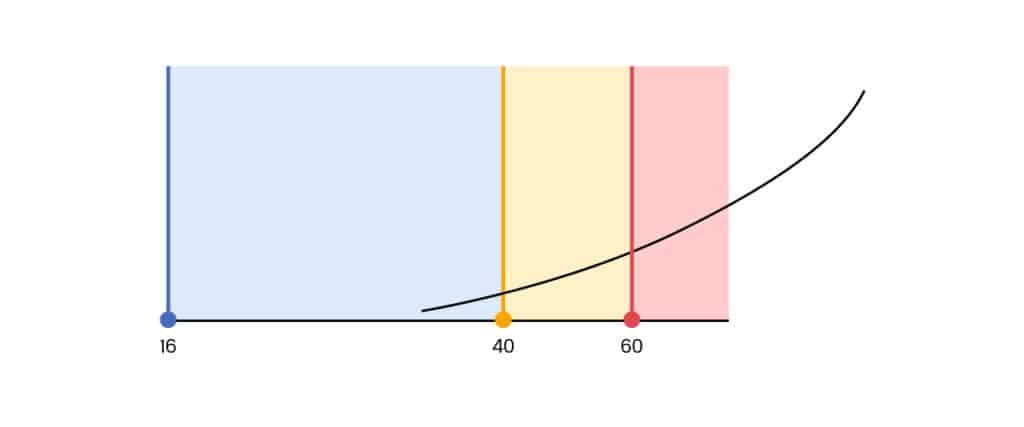
The graph depicts the progression of adult-onset scoliosis, illustrating that the risk of curve progression remains low from age 16 until around age 40. After 40, the risk becomes moderate and significantly increases after age 60, emphasizing the need for monitoring and potential intervention in middle-aged and older adults to manage scoliosis effectively.
Are you experiencing pain?
Scoliosis and Pain
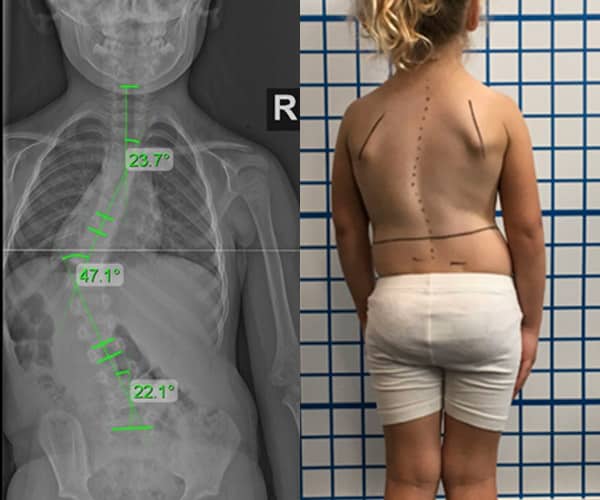
It is NOT common for children with scoliosis pain, no matter what size the curve is.
- If anything, a dull mild ache.
- This is because progression is due to growth, which is elongating.
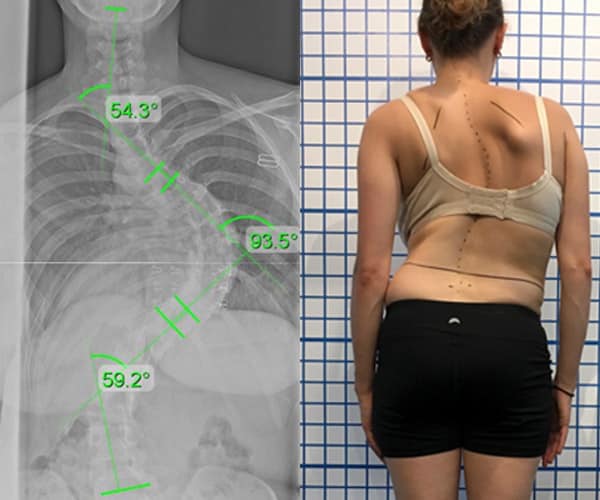
The opposite is true for adults with scoliosis, who will almost always feel pain, even with relative mild progression.
- This is because progression is due to gravity, which is almost always painful.
The Traditional Treatment Approach
- Very black and white.
- It is all based upon the size of the curve and the risk of progression.
If you’re diagnosed with a Mild Scoliosis:
10° – 25° Cobb Angle
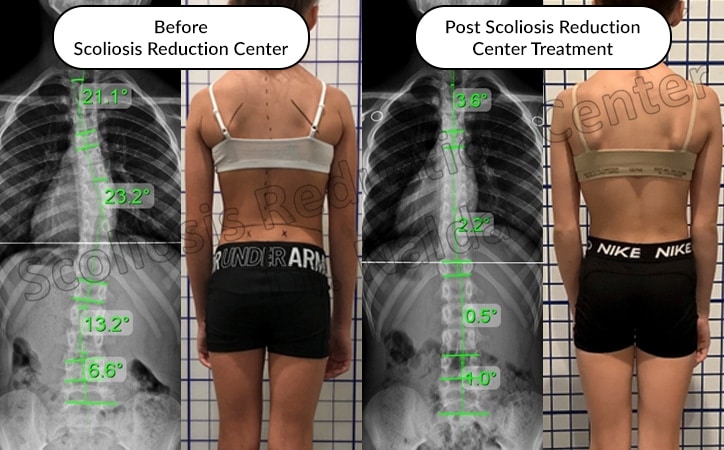
Traditional Treatment Says:
There is NOTHING you can do, just “Watch & Wait”.
Problems of this approach:
- All big curves were once small
- There is no harm in reducing a small curve, however there is in letting a small curve become large
- Small curves are easier to reduce
- If your treatment wasn’t an invasive surgery, you would reduce it buy they have nothing to offer
Chance of progressing to a surgical level curve is 30%!
If you’re diagnosed with a Moderate Scoliosis:
25° – 40° Cobb Angle
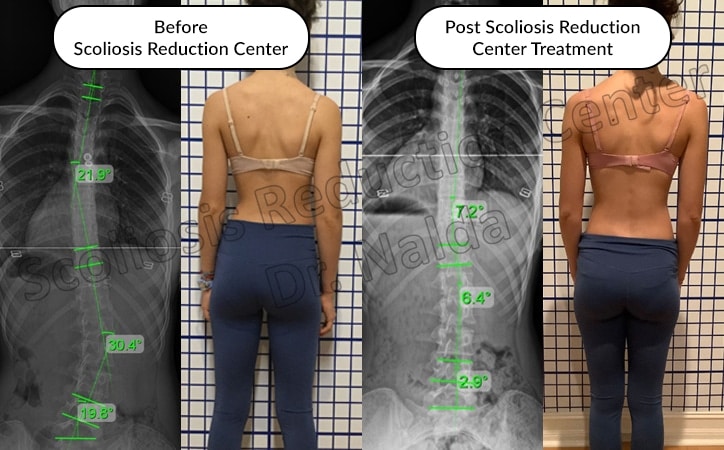
Traditional Treatment Says:
There is nothing you can do, just continue to “watch & wait”, or wear a traditional Boston Brace
Problems of this approach:
- It’s a squeezing brace style
- Boston brace is designed to just try to slow down progression, not reduce or improve the curve.
- If you are still growing, then your curve will probably progress even more.
Chance of progressing to a surgical level curve is 66%!
If you’re diagnosed with a Severe Scoliosis:
40°+ Cobb Angle
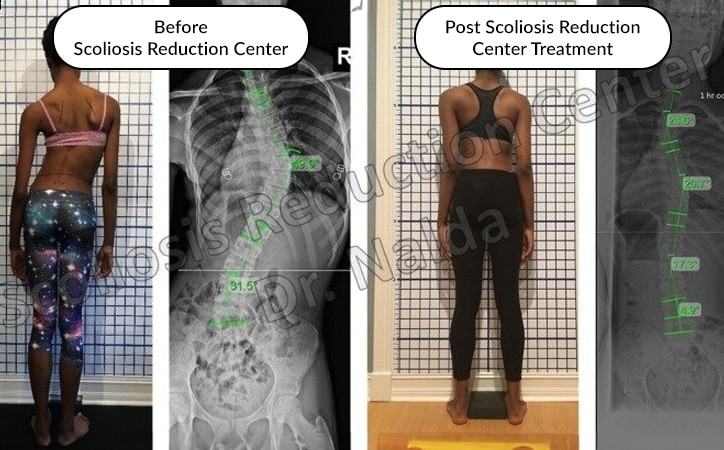
Traditional Treatment Says:
There is NOTHING you can do, until you are ready for surgery.
Problems of this approach:
- Surgery will reduce the curve but at an ultimate expense: Complete and total fusion of the spine.
- Future risks are unknown
- The reason why they wait until 40+ degrees, is because of the risks associated.
- If there was no risk, they would do surgery way sooner.
- Curves still progress as adults, but slower due to gravity (1 degree per year)
I call all of this the “Limited” approach!
I call it that because the goal of any of the above treatment is either to do nothing, to limit motion with a squeezing brace, or to use surgical rods and screws.
The Traditional Treatment Approach for Adults
If you’re diagnosed with a Mild Scoliosis:
10° – 25° Cobb Angle
Just “Watch & Wait”
Most say: “Don’t worry about it. There’s nothing we can do.”
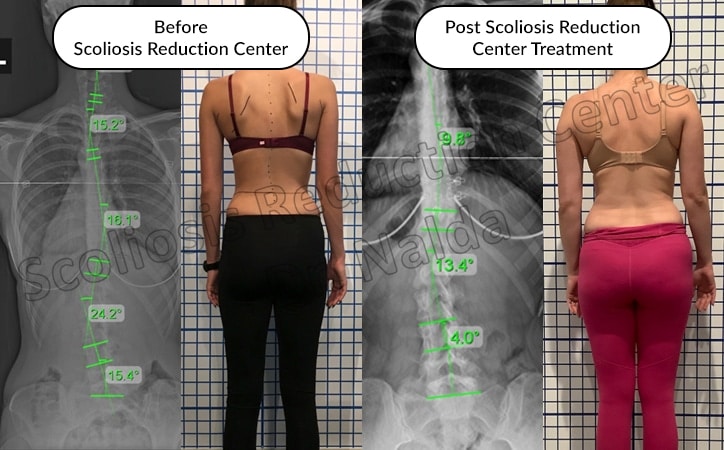
If you’re diagnosed with a Moderate Scoliosis:
25° – 40° Cobb Angle
Just “Watch & Wait”
Same story here: “Don’t worry about it. There’s nothing we can do.”
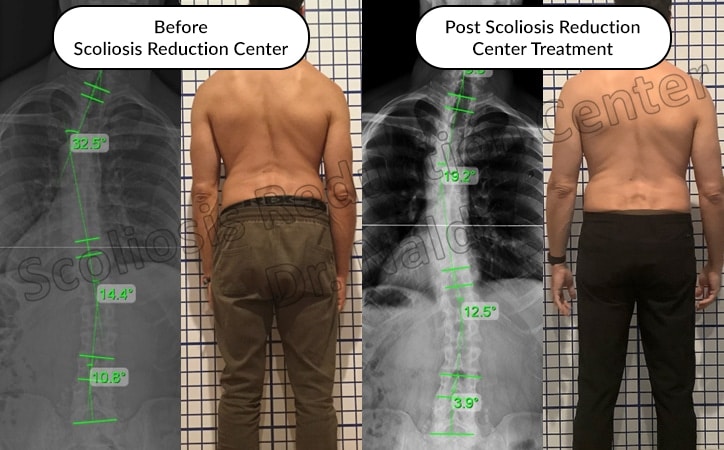
If you’re diagnosed with a Severe Scoliosis:
40°+ Cobb Angle
Surgery
- Now what do you expect? You have severe scoliosis.
- However, with surgery, the rate of complication is so high that they will only consider it if the person is in dire condition.
- So, even if your curve is “big enough” to have surgery, you may still be waiting for it to cause enough problems to risk surgery.
- As you get older, the complication of surgery increases.
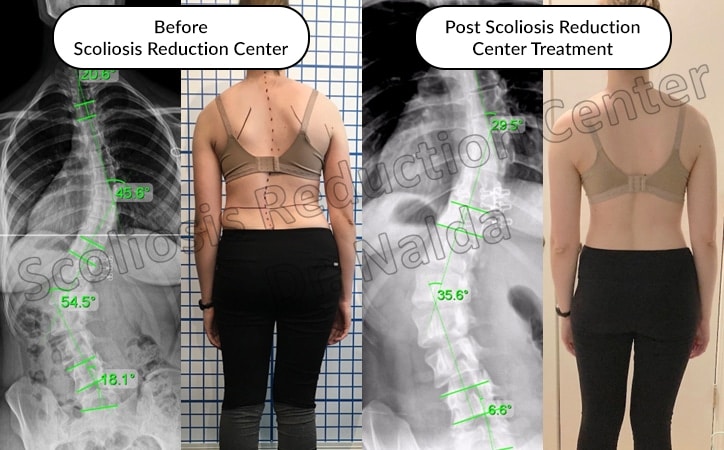
If you have pain at ANY time, they just treat your pain with typical pain treatments, NOT what is causing it.
I call all of this the “Limited” approach!
I call it that because the goal of any of the above treatment is either to do nothing, to limit motion with a squeezing brace, or to use surgical rods and screws.
How about a FUNCTIONAL approach?
The goal of a functional approach is to reduce the curve but retain the normal function of the spine.
The single largest factor if your curve will progress is related to size. So, reducing the curve is the best way to prevent progression.
Alternate Progression Model for Adolescents
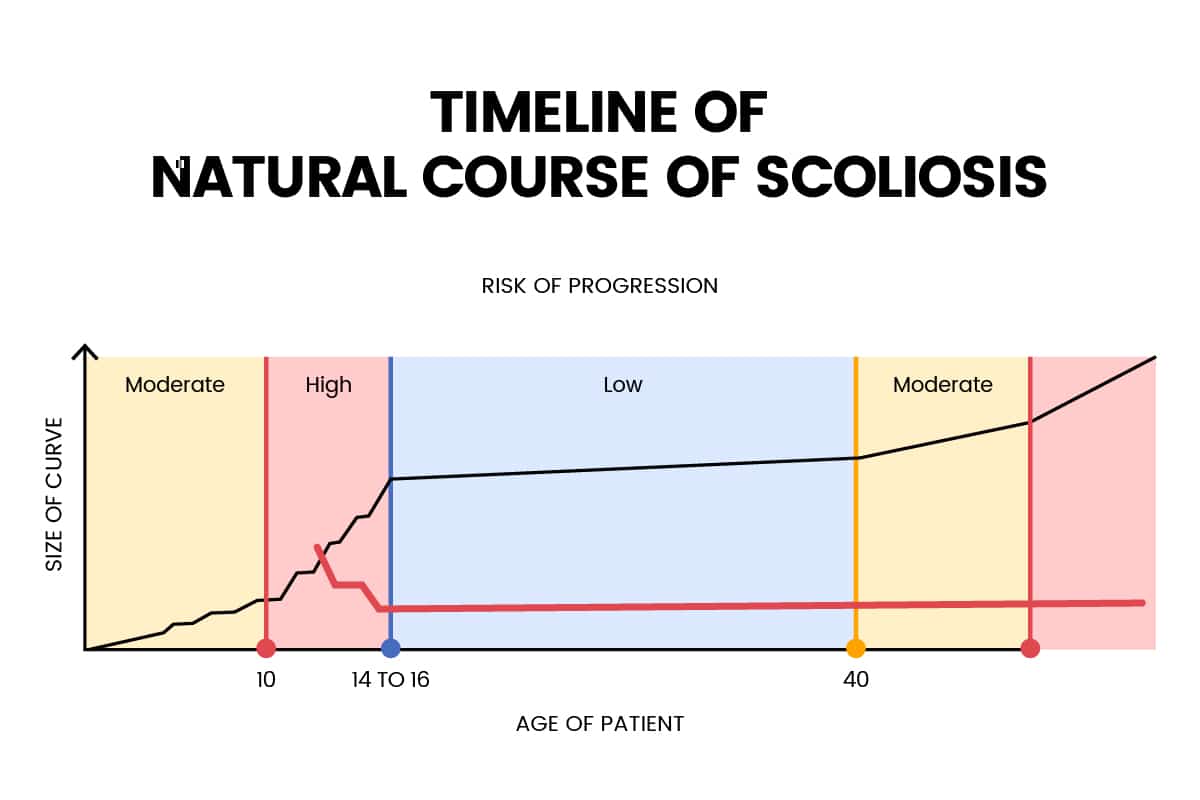
While the risk of curve progression is moderate during early childhood and high between ages 10 and 16, the red lines illustrate that timely intervention can stabilize the curve during these high-risk periods, preventing further significant progression. As a result, the intervention helps maintain a lower risk of curve progression through adulthood, highlighting the importance of early and consistent treatment.
How about a FUNCTIONAL approach?
The goal of a functional approach is to reduce the curve but retain the normal function of the spine.
The single largest factor if your curve will progress is related to size. So, reducing the curve is the best way to prevent progression.
Alternate Progression Model for Adults with Adolescent Scoliosis
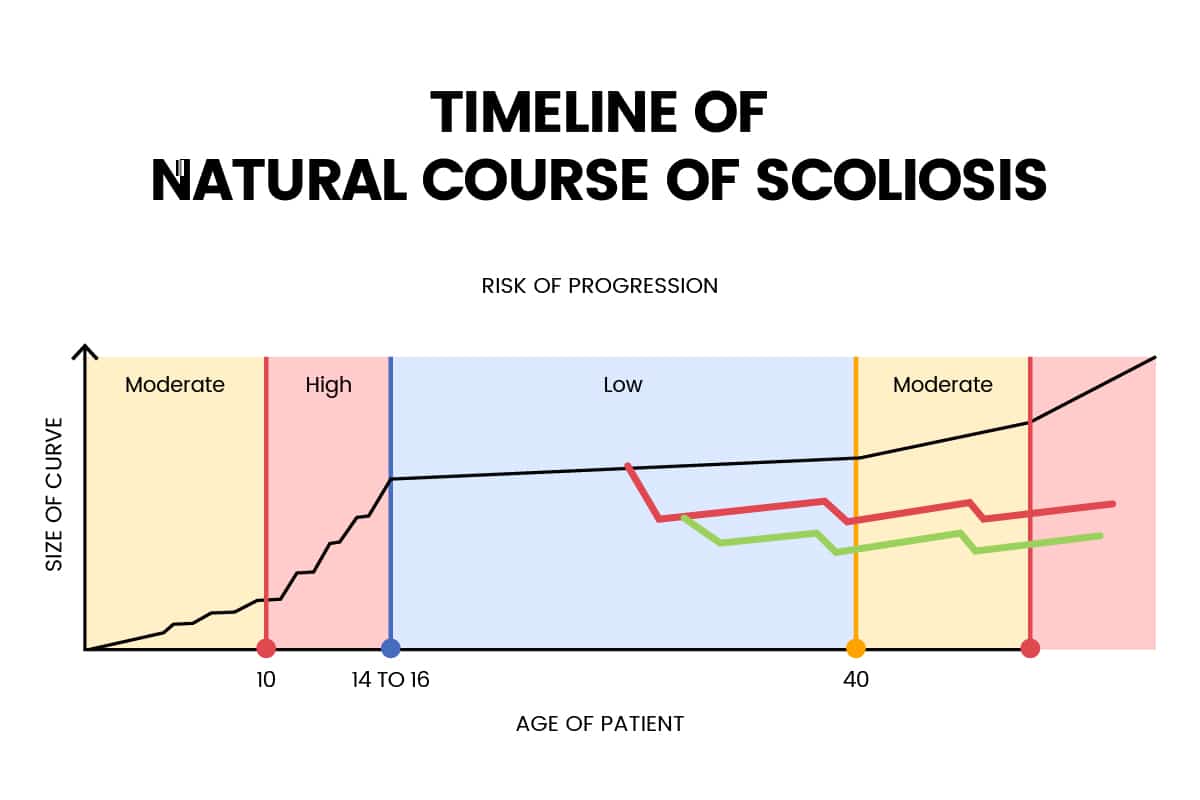
The graph illustrates the progression of scoliosis in adults who had adolescent scoliosis, showing the potential impact of treatment. Without treatment, the red line indicates that the curve may continue to worsen over time, particularly after age 60. With treatment, as shown by the green line, the progression can be significantly slowed or stabilized, maintaining a lower curve size and reducing the risk of severe progression in later years.
Alternate Progression Model for Adult-Onset Scoliosis
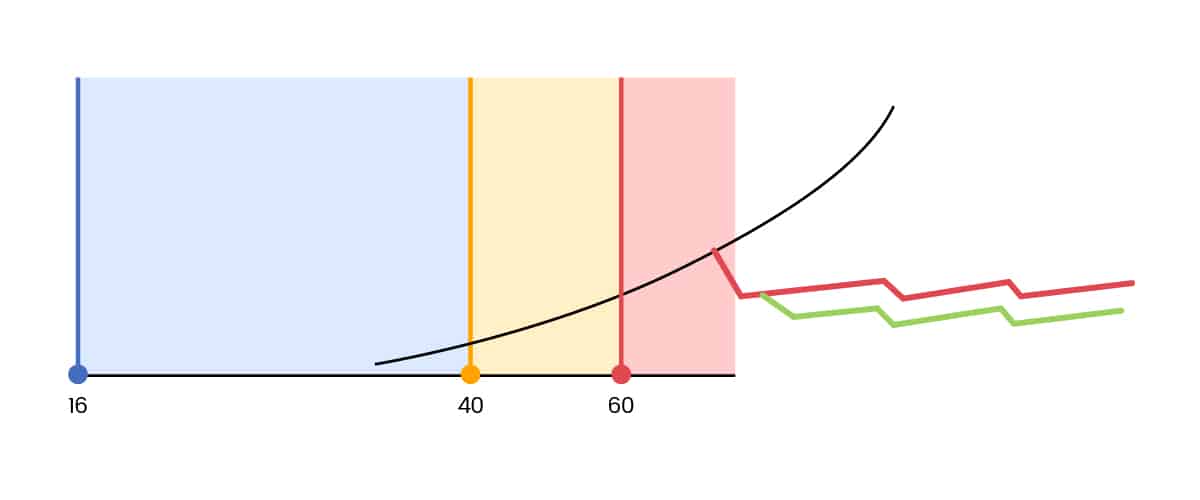
The graph presents an alternate progression model for adult-onset scoliosis when receiving treatment. Without treatment, indicated by the blue line, the scoliosis curve increases significantly, particularly after age 60. With treatment, as represented by the red and green lines, the progression is significantly slowed or stabilized, maintaining a lower curve size and mitigating the risk of severe progression. This highlights the importance of timely and consistent treatment in managing adult-onset scoliosis effectively.
So how do you reduce your curve?
Long Dose vs. Short Dose
Why orthopedic doctors don’t believe conservative care works:
Most doctors think of conservative care as injury-style treatment.
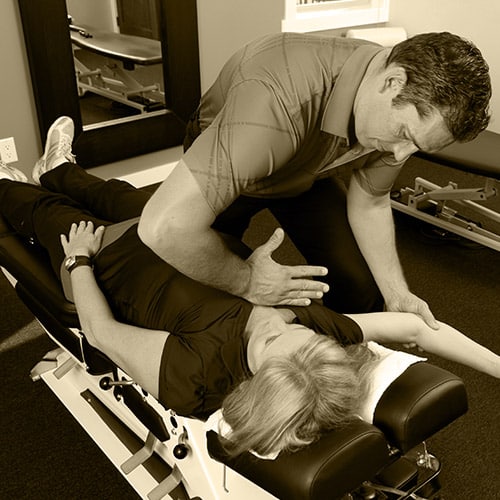
Traditional Therapy / Rehab / Chiropractic
- Little dose over a long time.
- Not enough intensity to reduce scoliosis.
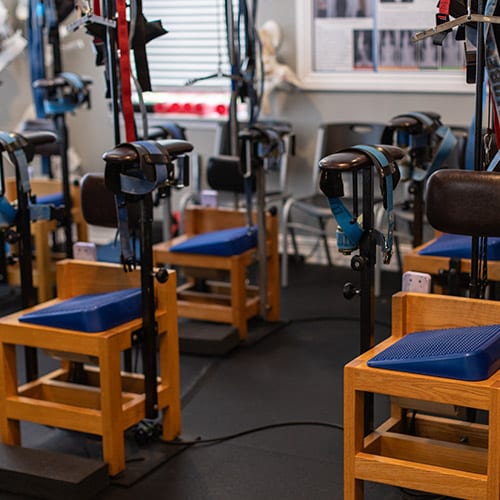
Our Intensive Care Approach:
- Big dose over a short time
- This type of intensity has a chance.
So how do you reduce your curve?
Long Dose vs. Short Dose
Why orthopedic doctors don’t believe conservative care works:
Most doctors think of conservative care as injury-style treatment.
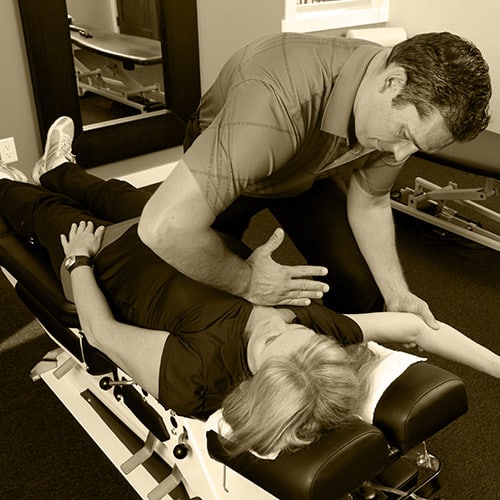
Traditional Therapy / Rehab / Chiropractic
- Little dose over a long time.
- Not enough intensity to reduce scoliosis.
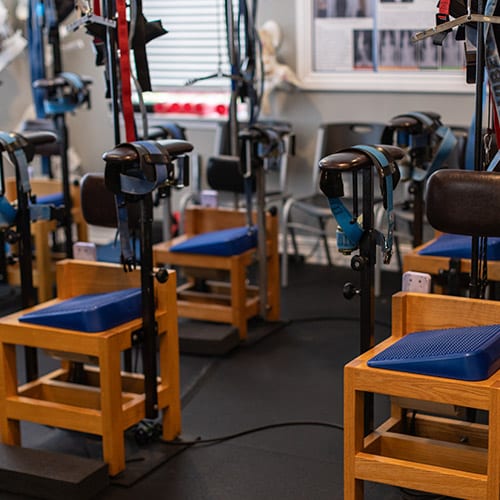
Our Intensive Care Approach:
- Big dose over a short time
- This type of intensity has a chance.
Squeezing Traditional Brace vs. Pushing Corrective ScoliBrace
As you can see below, scoliosis is not a 2-dimensional problem that only consist of lateral bending of the spine, but it is actually a 3-dimensional problem. This top view of a scoliosis patient shows how the torso/ribs and spine rotate as well as bend.
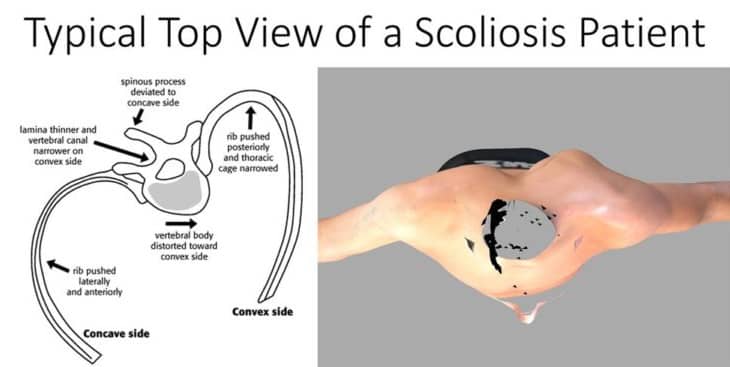
Typical Boston braces don’t address the rotational component of scoliosis because they only squeeze the body from the sides. In fact, squeezing from the sides can increase rotation while attempting to control lateral spine bending.
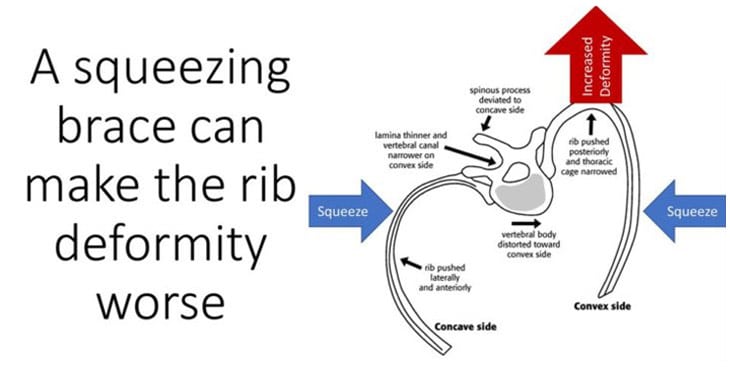
Below is an example of a patient that wore a typical squeezing style Boston brace. Here you can see how the rib deformity has become more pronounced and pointier in nature. Unfortunately, this is a common consequence of a brace that squeezes.
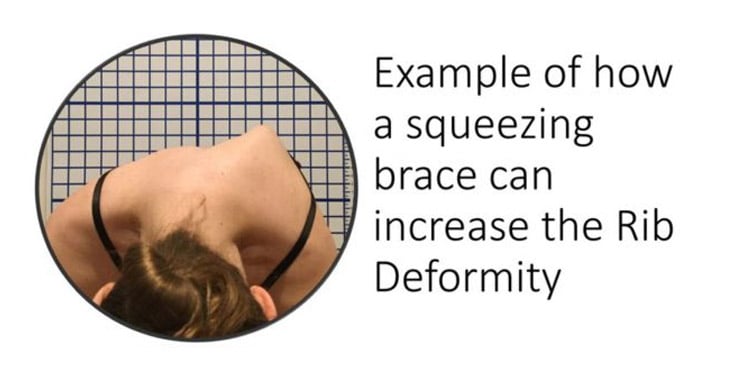
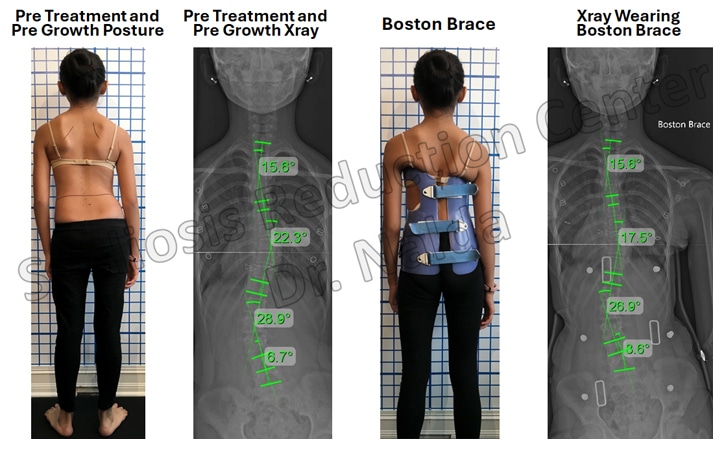
Traditional Bracing
Uses squeezing to try to slow down progression.
This patient’s Boston Brace provides no correction showing 28 degrees on her Out of Brace x-ray, with the same result of 28 degrees In Boston Brace X-ray. The Boston brace reduced the curve 0 degrees in brace.
Curve reduction is not possible or expected with Boston-style braces.
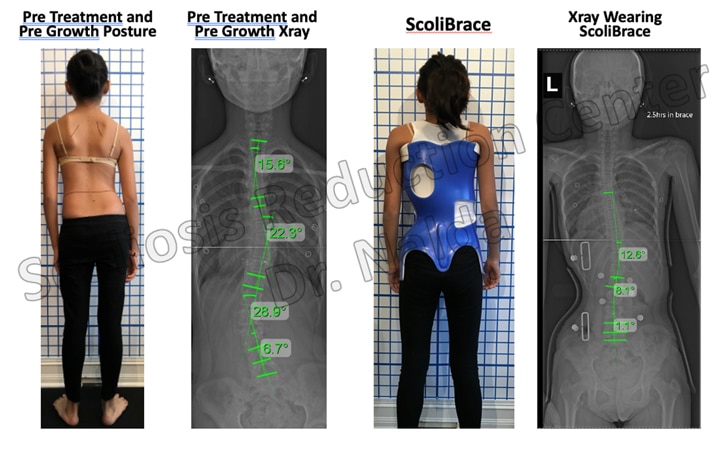
Corrective Bracing
Uses pushing to try to reduce the curve.
Same patient in corrective brace goes from 28 to 8 degrees in a ScoliBrace. The corrective brace reduces the curve 71% in her ScoliBrace
Curve reduction can be expected especially if combined with proper therapy, rehab and exercises
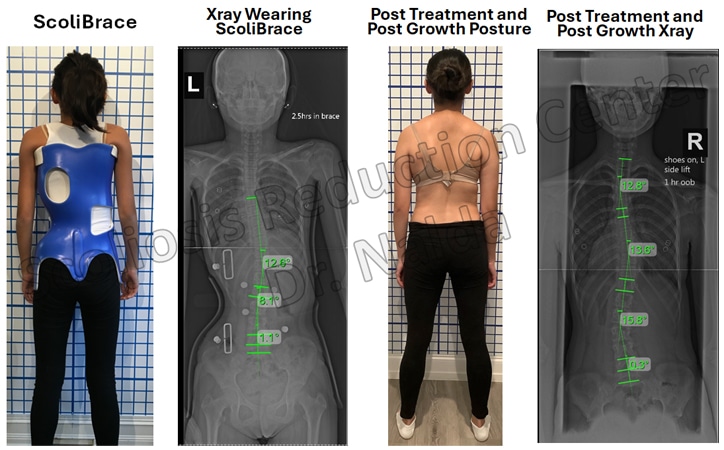
Boston Brace vs ScoliBrace
ScoliBrace combined with Treatment = Results
Same patient after proper corrective ScoliBrace combined with our complete treatment program. Curve reduction is possible with the right tools and the right treatment approach.
Following Intensive care, we need stability…
Core Exercise vs Scoliosis-Specific Exercise

Traditional Exercise:
- Planks, general flexibility, etc.
- Core strengthening only.
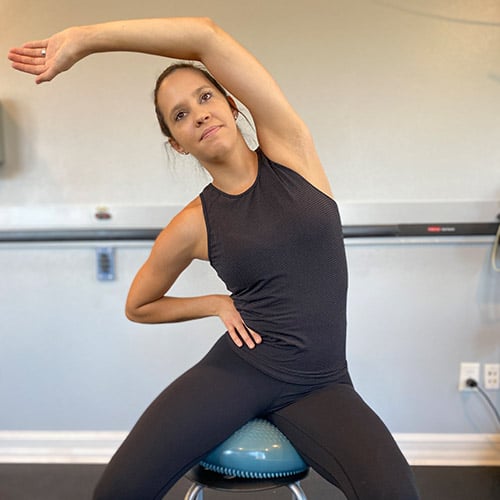
Scoliosis Exercise:
- Asymmetrical exercises that are designed to address the curve size.
- Isometric exercises, reactive exercises, and self-corrective exercises.
Squeezing Traditional Brace vs. Pushing Corrective ScoliBrace
As you can see below, scoliosis is not a 2-dimensional problem that only consist of lateral bending of the spine, but it is actually a 3-dimensional problem. This top view of a scoliosis patient shows how the torso/ribs and spine rotate as well as bend.

Typical Boston braces don’t address the rotational component of scoliosis because they only squeeze the body from the sides. In fact, squeezing from the sides can increase rotation while attempting to control lateral spine bending.

Below is an example of a patient that wore a typical squeezing style Boston brace. Here you can see how the rib deformity has become more pronounced and pointier in nature. Unfortunately, this is a common consequence of a brace that squeezes.


Traditional Bracing
Uses squeezing to try to slow down progression.
This patient’s Boston Brace provides no correction showing 28 degrees on her Out of Brace x-ray, with the same result of 28 degrees In Boston Brace X-ray. The Boston brace reduced the curve 0 degrees in brace.
Curve reduction is not possible or expected with Boston-style braces.
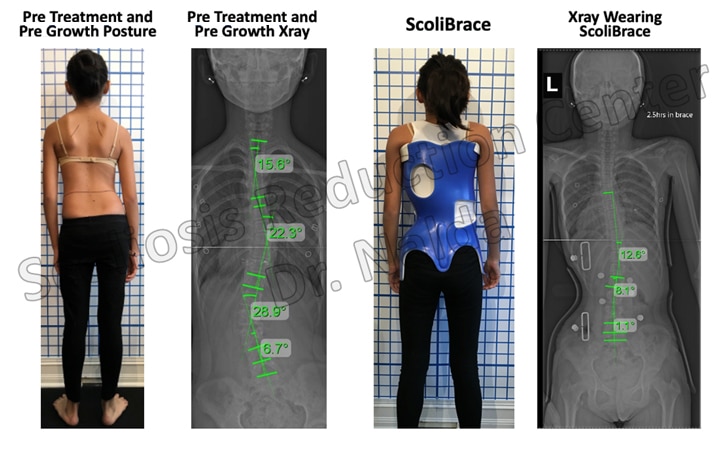
Corrective Bracing
Uses pushing to try to reduce the curve.
Same patient in corrective brace goes from 28 to 8 degrees in a ScoliBrace. The corrective brace reduces the curve 71% in her ScoliBrace
Curve reduction can be expected especially if combined with proper therapy, rehab and exercises

Boston Brace vs ScoliBrace
ScoliBrace combined with Treatment = Results
Same patient after proper corrective ScoliBrace combined with our complete treatment program. Curve reduction is possible with the right tools and the right treatment approach.
Following Intensive care, we need stability…
Core Exercise vs Scoliosis-Specific Exercise

Traditional Exercise:
- Planks, general flexibility, etc.
- Core strengthening only.

Scoliosis Exercise:
- Asymmetrical exercises that are designed to address the curve size.
- Isometric exercises, reactive exercises, and self-corrective exercises.
So how do you reduce your curve?
Fragmented vs. Coordinated
A Multimodal Approach Is Needed:
- Therapy
- Chiropractic
- Traction
- Rehab
- Exercise
- Vibration
- Percussion
- Bracing & Brace Design
- Self-correction Exercisses
- Isometrics
But this approach can create problems!
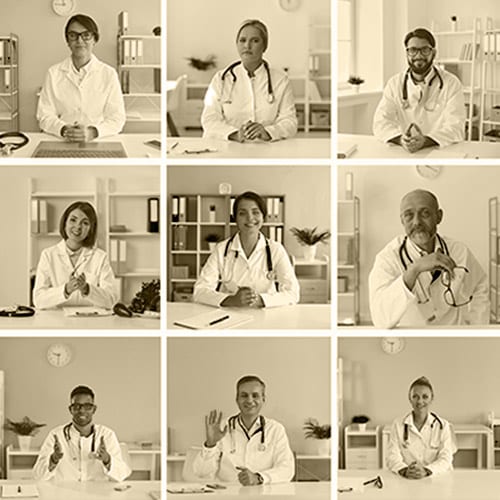
Fragmented Approach:
You would have to see many different certified doctors and therapists to get all of these modalities!
This results in fragmented care, that more than likely, will be competing or counteracting each other.
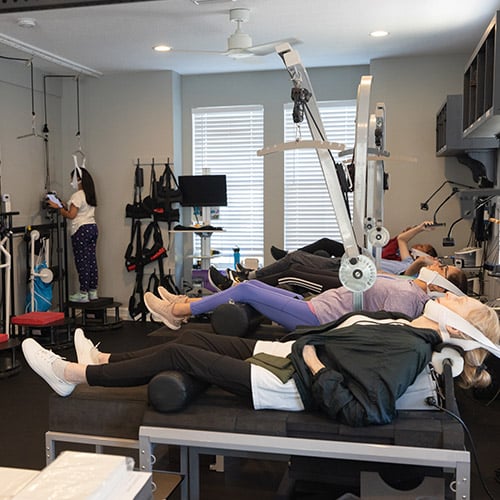
Coordinated Approach:
One doctor, certified in all of the multiple modalities, is coordinating and prescribing everything to work together.
This leads to results that you cannot see with any other sort of approach!
Slowing Down Your Progression vs. Managing Your Curve Reduction
Slowing Progression:
- Traditionally, if your curve continues to progress, nothing really changes until it becomes severe enough to warrant the risk of surgery
- Just trying to slow down progression
Managing Your Reduction:
- We are trying to get as much reduction as possible. We are managing your reduction.
- It is a completely different mindset!
So how do you reduce your curve?
Fragmented vs. Coordinated
A Multimodal Approach Is Needed:
- Therapy
- Chiropractic
- Traction
- Rehab
- Exercise
- Vibration
- Percussion
- Bracing & Brace Design
- Self-correction Exercisses
- Isometrics
But this approach can create problems!

Fragmented Approach:
You would have to see many different certified doctors and therapists to get all of these modalities!
This results in fragmented care, that more than likely, will be competing or counteracting each other.

Coordinated Approach:
One doctor, certified in all of the multiple modalities, is coordinating and prescribing everything to work together.
This leads to results that you cannot see with any other sort of approach!
Slowing Down Your Progression vs. Managing Your Curve Reduction
Slowing Progression:
- Traditionally, if your curve continues to progress, nothing really changes until it becomes severe enough to warrant the risk of surgery
- Just trying to slow down progression
Managing Your Reduction:
- We are trying to get as much reduction as possible. We are managing your reduction.
- It is a completely different mindset!
During Active Care
(Actively Trying To Reduce Your Curve)
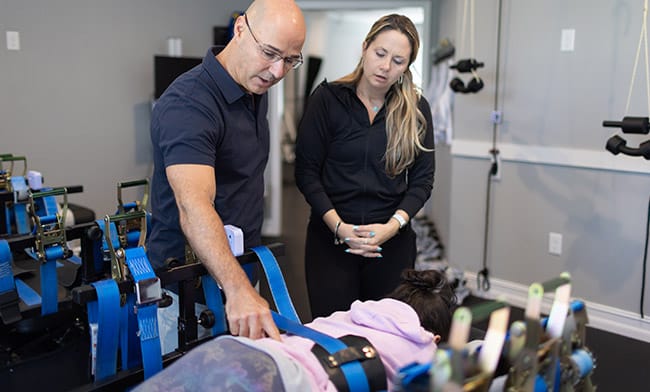
Once we reduce your curve:
- Every 90 days, we are re-evaluating looking for more opportunity to reduce your curve, with possible modification.
- Sometimes we will continue, but other times we may modify the brace to make it more aggressive, do another 1 week intensive, etc…
- Like braces on your teeth, the orthodontist will keep adjusting the braces until your teeth get as straight as possible. We do the same with our treatment.
After 18 months, and if the child is fully grown, we can consider the weaning process if we are happy with the results.
- However, some patients continue to try to get more reduction if I think it is possible.
Once we are done with active care:
- We slowly wean down everything and start the correct maintenance care to prevent slow progression over time due to gravity.
- We figure out your maintenance by slowly reducing your dose of treatment (office care, bracing, home exercises).
- If there is no progression, we continue to reduce the dose to get your maintenance program to be as little as possible.
- The smaller your curve becomes, the less you will need to do.
There is NO SUCH THING as a permanent cure.
You will always have to maintain.
If there is some regression in the future, we will use another round of intensive care.
During Active Care
(Actively Trying To Reduce Your Curve)

Once we reduce your curve:
- Every 90 days, we are re-evaluating looking for more opportunity to reduce your curve, with possible modification.
- Sometimes we will continue, but other times we may modify the brace to make it more aggressive, do another 1 week intensive, etc…
- Like braces on your teeth, the orthodontist will keep adjusting the braces until your teeth get as straight as possible. We do the same with our treatment.
After 18 months, and if the child is fully grown, we can consider the weaning process if we are happy with the results.
- However, some patients continue to try to get more reduction if I think it is possible.
Once we are done with active care:
- We slowly wean down everything and start the correct maintenance care to prevent slow progression over time due to gravity.
- We figure out your maintenance by slowly reducing your dose of treatment (office care, bracing, home exercises).
- If there is no progression, we continue to reduce the dose to get your maintenance program to be as little as possible.
- The smaller your curve becomes, the less you will need to do.
There is NO SUCH THING as a permanent cure.
You will always have to maintain.
If there is some regression in the future, we will use another round of intensive care.
Case Studies
Even though every case is different, see the results we’ve been able to get for patients like you.

Summary
- We use intensive therapy to achieve a rapid reduction in your curve
- All the therapy is coordinated by one doctor.
- We then prescribe home therapy and coordinate with local doctors to stabilize the reduction
- If needed, we design a brace to match all therapy that is performed
- Brace is a corrective brace to help reduce the curve
- During Active Care, we re-evaluate every 90 days to make sure it is stable, and make adjustments to care, home care, brace, etc. to get as much of a reduction as possible.
- Once through Active Care, we slowly wean to find the appropriate maintenance care.

Juvenile Case Studies
Neuromuscular
Summary
- We use intensive therapy to achieve a rapid reduction in your curve
- All the therapy is coordinated by one doctor.
- We then prescribe home therapy and coordinate with local doctors to stabilize the reduction
- If needed, we design a brace to match all therapy that is performed
- Brace is a corrective brace to help reduce the curve
- During Active Care, we re-evaluate every 90 days to make sure it is stable, and make adjustments to care, home care, brace, etc. to get as much of a reduction as possible.
- Once through Active Care, we slowly wean to find the appropriate maintenance care.

Adolescent Case Studies
Idiopathic
Summary
- We use intensive therapy to achieve a rapid reduction in your curve
- All the therapy is coordinated by one doctor.
- We then prescribe home therapy and coordinate with local doctors to stabilize the reduction
- If needed, we design a brace to match all therapy that is performed
- Brace is a corrective brace to help reduce the curve
- During Active Care, we re-evaluate every 90 days to make sure it is stable, and make adjustments to care, home care, brace, etc. to get as much of a reduction as possible.
- Once through Active Care, we slowly wean to find the appropriate maintenance care.

Adult Case Studies
Severe
Summary
- We use intensive therapy to achieve a rapid reduction in your curve
- All the therapy is coordinated by one doctor.
- We then prescribe home therapy and coordinate with local doctors to stabilize the reduction
- If needed, we design a brace to match all therapy that is performed
- Brace is a corrective brace to help reduce the curve
- During Active Care, we re-evaluate every 90 days to make sure it is stable, and make adjustments to care, home care, brace, etc. to get as much of a reduction as possible.
- Once through Active Care, we slowly wean to find the appropriate maintenance care.
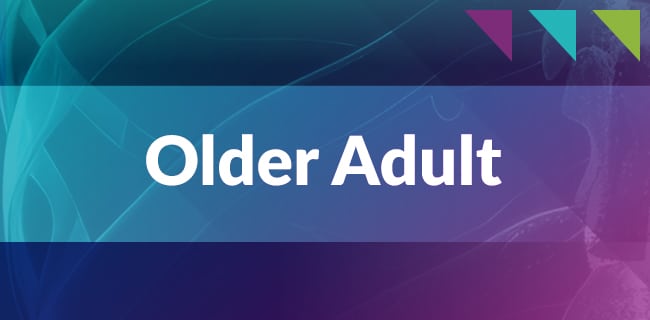
Older Adult Case Studies
Moderate
Summary
- We use intensive therapy to achieve a rapid reduction in your curve
- All the therapy is coordinated by one doctor.
- We then prescribe home therapy and coordinate with local doctors to stabilize the reduction
- If needed, we design a brace to match all therapy that is performed
- Brace is a corrective brace to help reduce the curve
- During Active Care, we re-evaluate every 90 days to make sure it is stable, and make adjustments to care, home care, brace, etc. to get as much of a reduction as possible.
- Once through Active Care, we slowly wean to find the appropriate maintenance care.